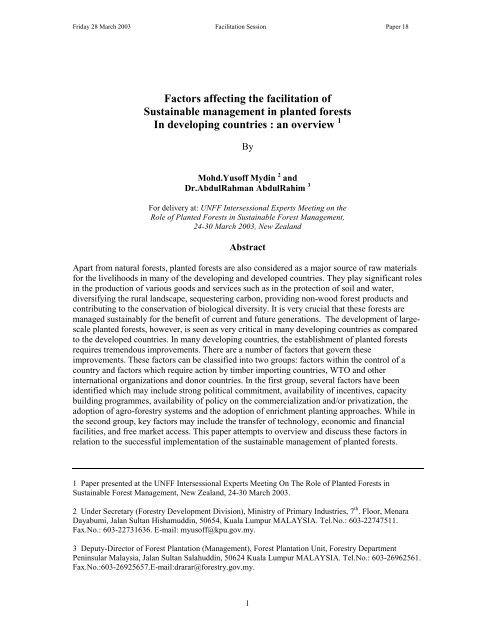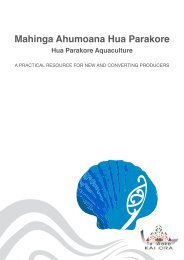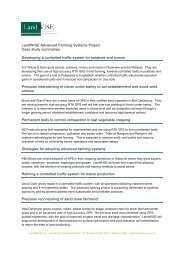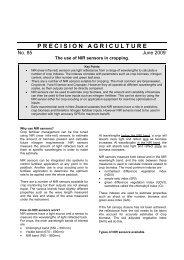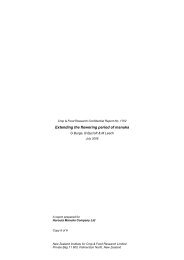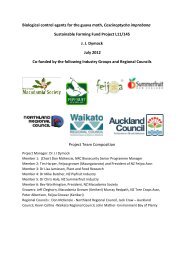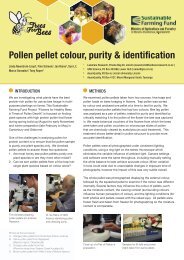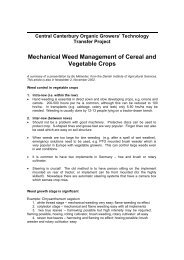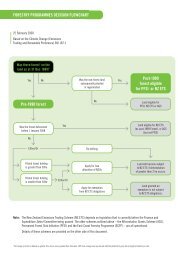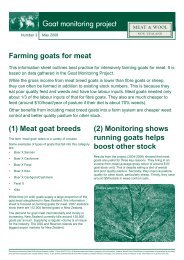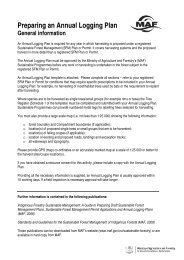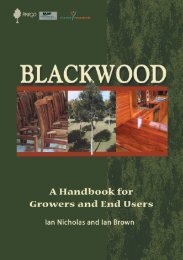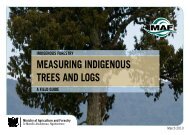Factors Affecting Facilitation in the Planted Forests - Ministry for ...
Factors Affecting Facilitation in the Planted Forests - Ministry for ...
Factors Affecting Facilitation in the Planted Forests - Ministry for ...
Create successful ePaper yourself
Turn your PDF publications into a flip-book with our unique Google optimized e-Paper software.
Friday 28 March 2003 <strong>Facilitation</strong> Session Paper 18<strong>Factors</strong> affect<strong>in</strong>g <strong>the</strong> facilitation ofSusta<strong>in</strong>able management <strong>in</strong> planted <strong>for</strong>estsIn develop<strong>in</strong>g countries : an overview 1ByMohd.Yusoff Myd<strong>in</strong> 2 andDr.AbdulRahman AbdulRahim 3For delivery at: UNFF Intersessional Experts Meet<strong>in</strong>g on <strong>the</strong>Role of <strong>Planted</strong> <strong>Forests</strong> <strong>in</strong> Susta<strong>in</strong>able Forest Management,24-30 March 2003, New ZealandAbstractApart from natural <strong>for</strong>ests, planted <strong>for</strong>ests are also considered as a major source of raw materials<strong>for</strong> <strong>the</strong> livelihoods <strong>in</strong> many of <strong>the</strong> develop<strong>in</strong>g and developed countries. They play significant roles<strong>in</strong> <strong>the</strong> production of various goods and services such as <strong>in</strong> <strong>the</strong> protection of soil and water,diversify<strong>in</strong>g <strong>the</strong> rural landscape, sequester<strong>in</strong>g carbon, provid<strong>in</strong>g non-wood <strong>for</strong>est products andcontribut<strong>in</strong>g to <strong>the</strong> conservation of biological diversity. It is very crucial that <strong>the</strong>se <strong>for</strong>ests aremanaged susta<strong>in</strong>ably <strong>for</strong> <strong>the</strong> benefit of current and future generations. The development of largescaleplanted <strong>for</strong>ests, however, is seen as very critical <strong>in</strong> many develop<strong>in</strong>g countries as comparedto <strong>the</strong> developed countries. In many develop<strong>in</strong>g countries, <strong>the</strong> establishment of planted <strong>for</strong>estsrequires tremendous improvements. There are a number of factors that govern <strong>the</strong>seimprovements. These factors can be classified <strong>in</strong>to two groups: factors with<strong>in</strong> <strong>the</strong> control of acountry and factors which require action by timber import<strong>in</strong>g countries, WTO and o<strong>the</strong>r<strong>in</strong>ternational organizations and donor countries. In <strong>the</strong> first group, several factors have beenidentified which may <strong>in</strong>clude strong political commitment, availability of <strong>in</strong>centives, capacitybuild<strong>in</strong>g programmes, availability of policy on <strong>the</strong> commercialization and/or privatization, <strong>the</strong>adoption of agro-<strong>for</strong>estry systems and <strong>the</strong> adoption of enrichment plant<strong>in</strong>g approaches. While <strong>in</strong><strong>the</strong> second group, key factors may <strong>in</strong>clude <strong>the</strong> transfer of technology, economic and f<strong>in</strong>ancialfacilities, and free market access. This paper attempts to overview and discuss <strong>the</strong>se factors <strong>in</strong>relation to <strong>the</strong> successful implementation of <strong>the</strong> susta<strong>in</strong>able management of planted <strong>for</strong>ests.1 Paper presented at <strong>the</strong> UNFF Intersessional Experts Meet<strong>in</strong>g On The Role of <strong>Planted</strong> <strong>Forests</strong> <strong>in</strong>Susta<strong>in</strong>able Forest Management, New Zealand, 24-30 March 2003.2 Under Secretary (Forestry Development Division), M<strong>in</strong>istry of Primary Industries, 7 th . Floor, MenaraDayabumi, Jalan Sultan Hishamudd<strong>in</strong>, 50654, Kuala Lumpur MALAYSIA. Tel.No.: 603-22747511.Fax.No.: 603-22731636. E-mail: myusoff@kpu.gov.my.3 Deputy-Director of Forest Plantation (Management), Forest Plantation Unit, Forestry DepartmentPen<strong>in</strong>sular Malaysia, Jalan Sultan Salahudd<strong>in</strong>, 50624 Kuala Lumpur MALAYSIA. Tel.No.: 603-26962561.Fax.No.:603-26925657.E-mail:drarar@<strong>for</strong>estry.gov.my.1
Friday 28 March 2003 <strong>Facilitation</strong> Session Paper 181.0 Introduction1.1 Globally, <strong>the</strong> dom<strong>in</strong>ant trends <strong>for</strong> <strong>for</strong>est products are an <strong>in</strong>creas<strong>in</strong>g demand <strong>for</strong>wood (result<strong>in</strong>g from <strong>in</strong>creas<strong>in</strong>g populations and <strong>in</strong>creas<strong>in</strong>g <strong>in</strong>comes) from adim<strong>in</strong>ish<strong>in</strong>g, or more restricted, <strong>for</strong>est supply base (Brown, 2001). Considerableattention has, consequently, focused on identify<strong>in</strong>g means to alleviate <strong>the</strong>potential wood and fibre shortfalls. For some countries a primary solution hasbeen to <strong>in</strong>crease imports of <strong>for</strong>est products significantly, <strong>the</strong>reby redistribut<strong>in</strong>gdemand to <strong>for</strong>est-rich countries. O<strong>the</strong>r solutions have <strong>in</strong>cluded <strong>in</strong>creased levels ofrecycl<strong>in</strong>g, improved process<strong>in</strong>g conversion efficiencies, <strong>in</strong>creased utilization of<strong>for</strong>est harvest<strong>in</strong>g residues, and <strong>the</strong> establishment of <strong>for</strong>est plantations.1.2 Forest plantations are somewhat synonymous to planted <strong>for</strong>ests. They are ‘manmade<strong>for</strong>ests’ and/or ‘artificially established’ through tree plant<strong>in</strong>g activity.Natural <strong>for</strong>ests will become less available <strong>for</strong> future timber harvest<strong>in</strong>g due toseveral causes, such as difficult terra<strong>in</strong>; remote locations, low productivity, poorstand quality and <strong>the</strong> lack of commercial species. Hence, planted <strong>for</strong>ests areconsidered as an alternative to natural <strong>for</strong>ests. To a certa<strong>in</strong> extent, planted <strong>for</strong>estshave served as a source of raw materials <strong>for</strong> livelihood <strong>in</strong> many of <strong>the</strong> develop<strong>in</strong>gand developed countries. These <strong>for</strong>ests play significant roles <strong>in</strong> <strong>the</strong> production ofvarious goods and services, such as protection of soil and water, diversificationof <strong>the</strong> rural landscape, sequester<strong>in</strong>g carbon, provid<strong>in</strong>g non-<strong>for</strong>est products andcontribut<strong>in</strong>g to <strong>the</strong> conservation of biological diversity. These <strong>for</strong>ests willcont<strong>in</strong>ue to play significant roles as mentioned above. There<strong>for</strong>e, it is vital that<strong>the</strong>se <strong>for</strong>ests are managed susta<strong>in</strong>ably <strong>for</strong> <strong>the</strong> benefit of current and futuregenerations.1.3 The development of large-scale planted <strong>for</strong>ests, however, is seen as very critical<strong>in</strong> many develop<strong>in</strong>g countries as compared to <strong>the</strong> developed countries. In manydevelop<strong>in</strong>g countries, <strong>the</strong> establishment of planted <strong>for</strong>ests requires tremendousimprovements. There are a number of factors that govern <strong>the</strong>se improvements.These factors can be classified <strong>in</strong>to two groups: factors with<strong>in</strong> <strong>the</strong> control of acountry and factors which require action by timber import<strong>in</strong>g countries, WorldTrade Organization (WTO) and o<strong>the</strong>r <strong>in</strong>ternational organizations and donorcountries. In <strong>the</strong> first group, several factors have been identified which may<strong>in</strong>clude strong political commitment, availability of <strong>in</strong>centives, capacity build<strong>in</strong>gprogrammes, availability of policy on <strong>the</strong> commercialization and/or privatization,<strong>the</strong> adoption of agro-<strong>for</strong>estry systems and <strong>the</strong> adoption of enrichment plant<strong>in</strong>gapproaches. While <strong>in</strong> <strong>the</strong> second group, key factors may <strong>in</strong>clude <strong>the</strong> transfer oftechnology, economic and f<strong>in</strong>ancial facilities and free market access. This paperattempts to overview and discuss <strong>the</strong>se factors <strong>in</strong> relation to <strong>the</strong> successfulimplementation of <strong>the</strong> susta<strong>in</strong>able management of planted <strong>for</strong>ests.2
Friday 28 March 2003 <strong>Facilitation</strong> Session Paper 182.0 <strong>Factors</strong> With<strong>in</strong> <strong>the</strong> Control of A Country2.1 Strong Political Commitment2.1.1 Political commitment is normally reflected by <strong>the</strong> stand of <strong>the</strong> rul<strong>in</strong>ggovernment <strong>in</strong> a country to <strong>the</strong> importance of <strong>for</strong>est plantationdevelopment. In this case, <strong>the</strong> government’s seriousness <strong>in</strong> <strong>the</strong>establishment of large-scale <strong>for</strong>est plantation must be fully supported by<strong>the</strong> existence of a strong national <strong>for</strong>est policy, clear developmentobjectives and a strong mandate <strong>for</strong> implementation. This is mostimportant <strong>for</strong> plantation establishment led by central or state-governmentplant<strong>in</strong>g programmes. The government has an important role to play <strong>in</strong>order to ensure successful establishment of large-scale planted <strong>for</strong>ests.2.1.2 The government may also adopt o<strong>the</strong>r approaches <strong>for</strong> <strong>the</strong> establishmentof large-scale <strong>for</strong>est plantation, such as us<strong>in</strong>g through community-baseddevelopment programmes and private sector <strong>in</strong>vestment. The f<strong>in</strong>alselection of <strong>the</strong> most suitable approach adopted is entirely governed by<strong>the</strong> government’s read<strong>in</strong>ess, as well as <strong>the</strong> availability of cleardevelopment objectives and a strong national <strong>for</strong>est policy.2.2 Availability of Incentives2.2.1 Incentives <strong>for</strong> plantation establishment are specifically created andprovided by a country <strong>for</strong> a variety of reasons. Gregerson (1984) def<strong>in</strong>ed<strong>in</strong>centives as “public subsidies given <strong>in</strong> various <strong>for</strong>ms to <strong>the</strong> privatesector to encourage socially desirable actions by private entities”. Thereare several <strong>for</strong>ms of <strong>in</strong>centives readily available, ei<strong>the</strong>r directly or<strong>in</strong>directly as provided <strong>for</strong> by each country. Direct <strong>in</strong>centives may <strong>in</strong>cludecost shar<strong>in</strong>g, subsidized credit, fiscal <strong>in</strong>centives, reduction of uncerta<strong>in</strong>tythrough loan guarantees, <strong>in</strong>surance, <strong>for</strong>est protection agreements, andprovision of land tenure (Gregersen and Houghtal<strong>in</strong>g, 1978). Meanwhile,<strong>in</strong>direct <strong>in</strong>centives may <strong>in</strong>clude provision of market <strong>in</strong><strong>for</strong>mation,extension and education, and research (Keipi, 1997).2.2.2 Generally, <strong>the</strong> primy justification <strong>for</strong> offer<strong>in</strong>g <strong>in</strong>centives is to raise <strong>the</strong>private sector returns to encourage a more socially desirable level ofplantation <strong>in</strong>vestment (Williams, 2000). Thus, <strong>in</strong>centives are onlyappropriate when <strong>the</strong> private sector net returns are lower while <strong>the</strong>returns <strong>in</strong>clud<strong>in</strong>g externalities are greater than <strong>the</strong> returns fromalternative land uses. In this situation, <strong>in</strong>centives could be effective bycreat<strong>in</strong>g a more socially desirable land-use pattern. On <strong>the</strong> contrary,<strong>in</strong>centives may not be so important if <strong>the</strong> private sector returns from<strong>for</strong>estry exceed those from o<strong>the</strong>r <strong>for</strong>ms of land use. Incentives are moreuseful to help <strong>in</strong>vestors overcome barriers such as <strong>the</strong> high <strong>in</strong>itial capitalcost of establishment and <strong>the</strong> relatively long wait<strong>in</strong>g period <strong>for</strong> <strong>the</strong>returns to be realized, as well as to encourage economic development andgenerate employment opportunities.2.2.3 In Pen<strong>in</strong>sular Malaysia, <strong>for</strong> example, fiscal <strong>in</strong>centives are provided <strong>for</strong> by<strong>the</strong> federal government to encourage <strong>in</strong>vestment <strong>in</strong> <strong>the</strong> establishment of3
Friday 28 March 2003 <strong>Facilitation</strong> Session Paper 18large-scale <strong>for</strong>est plantation. Incentives <strong>in</strong> <strong>the</strong> <strong>for</strong>m of “Pioneer Status(PS)”, “Investment Tax Allowances (ITA)” and “InfrastructureAllowance (IA)” are offered to <strong>the</strong> private sector <strong>in</strong>volved <strong>in</strong> <strong>for</strong>estplantation establishment. “Pioneer Status” provides 100% exemption of<strong>in</strong>come tax <strong>for</strong> a period of 10 years after harvest<strong>in</strong>g date (productionperiod). “Investment Tax Allowance” allows a 100% tax exemption of<strong>the</strong> qualify<strong>in</strong>g capital expenditure <strong>in</strong>curred with<strong>in</strong> 5 years of <strong>in</strong>itialestablishment, which could be deducted from <strong>the</strong> statutory <strong>in</strong>come of <strong>the</strong>company. “Infrastructure Allowance”, allows sett<strong>in</strong>g off of expenditure<strong>in</strong>curred <strong>in</strong> permanent <strong>in</strong>frastructure development aga<strong>in</strong>st company<strong>in</strong>come.2.3 Capacity Build<strong>in</strong>g Programmes2.3.1 Effective programmes <strong>in</strong>volv<strong>in</strong>g <strong>the</strong> development and transfer oftechnology <strong>in</strong> various aspects of planted <strong>for</strong>ests from developed todevelop<strong>in</strong>g countries are <strong>in</strong>deed very timely. This has lead to a call <strong>for</strong><strong>the</strong> establishment of an effective mechanism of capacity build<strong>in</strong>gprogrammes from <strong>the</strong> donor countries to <strong>the</strong> recipient country <strong>in</strong>volved<strong>in</strong> <strong>for</strong>est plantations development. Through well-planned tra<strong>in</strong><strong>in</strong>gschedules, <strong>the</strong> developed countries (donor) may be able to transfertechnical know-how to <strong>the</strong> develop<strong>in</strong>g countries (recipient). Capacitybuild<strong>in</strong>g programmes may be planned accord<strong>in</strong>g to <strong>the</strong> requirements of acountry. Some of <strong>the</strong> areas <strong>in</strong> which capacity build<strong>in</strong>g could be enhanced<strong>in</strong>clude reduc<strong>in</strong>g risk from pests and disease and <strong>for</strong>estry research.2.4 Availability of Policy on Commercialization and /or Privatization of ForestPlantations2.4.1 The FAO study <strong>in</strong> <strong>the</strong> Asia-Pacific Region shows that <strong>the</strong>re are notablythree dist<strong>in</strong>ct models commonly applied <strong>for</strong> <strong>the</strong> establishment of largescale<strong>for</strong>est plantation (Durst et. al., 2000). Any country may adopt <strong>the</strong>semodels which may <strong>in</strong>volve any one or a comb<strong>in</strong>ation of <strong>the</strong> follow<strong>in</strong>gactivities:-i. plantation establishment led by a central or state-governmentplant<strong>in</strong>g programmes;ii.iii.plantation establishment under community-baseddevelopment; andprivate sector-led plantation establishment.2.4.2 The first model is particularly notable <strong>in</strong> Ch<strong>in</strong>a and Vietnam as well as <strong>in</strong>Malaysia. It has been reported that, <strong>the</strong> Ch<strong>in</strong>ese Government plans to<strong>in</strong>crease <strong>the</strong> country’s <strong>for</strong>est cover from 14 percent to about 17 percentby 2010. In this endeavour, <strong>the</strong> government attaches great importance to<strong>for</strong>estry development through various government-supported plant<strong>in</strong>gprogrammes, <strong>in</strong>clud<strong>in</strong>g <strong>the</strong> promotion of private sector participation withfund<strong>in</strong>g through <strong>for</strong>eign <strong>in</strong>vestment and jo<strong>in</strong>t ventures. In Vietnam, it hasbeen reported that <strong>the</strong> government plans to establish a total of 5 million4
Friday 28 March 2003 <strong>Facilitation</strong> Session Paper 18hectares by 2010 its through national re<strong>for</strong>estation programme. InMalaysia, <strong>the</strong> Compensatory Forest Plantation Project (CFPP) waslaunched <strong>in</strong> 1982 to meet <strong>the</strong> projected wood requirements of <strong>the</strong> woodbased<strong>in</strong>dustries <strong>in</strong> Pen<strong>in</strong>sular Malaysia. The CFPP plans to establishabout 100,000 hectares of plantations based on a 15-year rotation of fastgrow<strong>in</strong>ghardwood species, such as Acacia mangium, Gmel<strong>in</strong>a arboreaand Paraserian<strong>the</strong>s falcataria. In <strong>the</strong> State of Sabah, Malaysia, <strong>the</strong> StateGovernment has earmarked about 800,000 hectares with<strong>in</strong> <strong>the</strong> PermanentForest Estate (PFE) and those outside <strong>the</strong> PFE <strong>for</strong> <strong>for</strong>est plantationestablishment; while <strong>in</strong> Sarawak, <strong>the</strong> State Government has set a targetto establish 1.4 million hectares of planted <strong>for</strong>est <strong>in</strong> <strong>the</strong> next 20 years.2.4.3 The second model is adopted notably <strong>in</strong> a number of develop<strong>in</strong>gcountries <strong>in</strong>clud<strong>in</strong>g India, Nepal, <strong>the</strong> Philipp<strong>in</strong>es, Bangladesh, Laos,Myanmar and Sri Lanka. Under this model, participatory activities <strong>in</strong>plantation establishment at all levels <strong>for</strong>m <strong>the</strong> key element (basic<strong>in</strong>gredient) <strong>for</strong> <strong>the</strong> successful implementation of <strong>the</strong> project. The basicconcept of this model recognizes <strong>the</strong> importance of <strong>the</strong> local people <strong>in</strong>protect<strong>in</strong>g, manag<strong>in</strong>g and develop<strong>in</strong>g <strong>for</strong>ests and envisages mobiliz<strong>in</strong>g<strong>the</strong> communities through <strong>the</strong> <strong>for</strong>mation of a unified <strong>in</strong>terested partycalled <strong>the</strong> “Village Forest Communities” or “People-Oriented ForestryProgrammes”. In this context, “Communities” are empowered to managedegraded <strong>for</strong>ests, <strong>in</strong>clud<strong>in</strong>g undertak<strong>in</strong>g out re<strong>for</strong>estation activities on abenefit shar<strong>in</strong>g basis. In <strong>the</strong> light of <strong>the</strong> current importance of <strong>for</strong>estcertification scheme, this model has great potential to be widely acceptedby <strong>the</strong> consumer countries.2.4.4 The third model which is carried out <strong>in</strong> many develop<strong>in</strong>g countries, <strong>in</strong><strong>for</strong>est plantation establishment is through <strong>the</strong> <strong>in</strong>volvement of <strong>the</strong> privatesector. In this model, <strong>the</strong> government <strong>in</strong>itially establishes a critical massof plantations, but ownership and responsibility <strong>for</strong> <strong>the</strong> management of<strong>the</strong> plantation is gradually handed over to <strong>the</strong> private sector. Countriesthat have adopted this model are New Zealand and Australia. Plantation<strong>for</strong>estry is regarded as a bus<strong>in</strong>ess and af<strong>for</strong>estation <strong>in</strong>vestments areprimarily assessed based on <strong>the</strong>ir potential profitability.2.5 Adoption of Agro-<strong>for</strong>estry Systems2.5.1 Agro-<strong>for</strong>estry basically <strong>in</strong>volves <strong>the</strong> <strong>in</strong>tentional <strong>in</strong>tegration of <strong>for</strong>estspecies <strong>in</strong>to exist<strong>in</strong>g agricultural land use systems (Najib et. al., 1999). Itis an <strong>in</strong>novative approach on land use and is capable of provid<strong>in</strong>gmultiple benefits that collectively contribute towards agro-ecosystemsusta<strong>in</strong>ability. As part of an ecological land based management system,agro-<strong>for</strong>estry practices if properly planned, implemented and managed,are capable of <strong>in</strong>creas<strong>in</strong>g profitability and ma<strong>in</strong>ta<strong>in</strong><strong>in</strong>g ecosystemdiversity and processes important to long-term susta<strong>in</strong>ability. Agro<strong>for</strong>estrycan also be considered as a <strong>for</strong>m of mixed farm<strong>in</strong>g.2.5.2 Agro-<strong>for</strong>estry has both protective and productive functions. The benefitscreated by agro-<strong>for</strong>estry practices can be biological, economic and5
Friday 28 March 2003 <strong>Facilitation</strong> Session Paper 18environmental. In terms of productive functions, <strong>the</strong> benefits are asfollows:-i. biologically, it could <strong>in</strong>crease space utilization, improvement ofsoil chemical, physical and biological properties, potentialreduction <strong>in</strong> soil erosion and reduction <strong>in</strong> microclimate extremes;ii. economically and socially, it could <strong>in</strong>crease productivity, <strong>in</strong>comeopportunity, variety of products and services, reduce risk frompests and diseases, reduce weed<strong>in</strong>g requirements and reduceestablishment cost; andiii. environmentally, it could control surface runoff and soil erosion,sequester carbon, filter and biodegrade excess nutrients andchemicals after fertilization, rehabilitate degraded land, <strong>in</strong>creaseproductivity of marg<strong>in</strong>al land, relieve pressure on overharvest<strong>in</strong>gof natural <strong>for</strong>est, protect environmentally sensitivelands, provide shelter, and <strong>in</strong>crease biodiversity.2.5.3 The practice of a agro-<strong>for</strong>estry systems may differ from place to place.However, <strong>in</strong> general, <strong>the</strong> three major components, namely agriculturecrops, <strong>for</strong>est species, and animals, can be grouped <strong>in</strong>to several categories,namely:-i. agro-silviculture systems – trees and agricultural crops;ii.silvi-pastoral systems - trees and livestock;iii. agro-silvi-pastoral systems - trees, agricultural crops andlivestock; andiv. o<strong>the</strong>r systems - aqua-<strong>for</strong>estry (fish-farm<strong>in</strong>g), api-<strong>for</strong>estry (beefarm<strong>in</strong>g).2.5.4 For <strong>the</strong> successful implementation of agro-<strong>for</strong>estry systems, <strong>the</strong>follow<strong>in</strong>g factors must be considered:-i. understand<strong>in</strong>g <strong>the</strong> growth requirements crops and/or animals tobe <strong>in</strong>tegrated <strong>in</strong> terms of light, moisture, nutrients, space etc.;ii.understand<strong>in</strong>g <strong>the</strong> basic growth factors of each componentspecies <strong>in</strong> terms of growth rates, crown shape and size, root<strong>in</strong>ghabits etc.;ii. growth duration <strong>in</strong> terms of period to harvest<strong>in</strong>g;iv. plant<strong>in</strong>g direction; andv. land topography.6
Friday 28 March 2003 <strong>Facilitation</strong> Session Paper 182.6 Adoption of Enrichment Plant<strong>in</strong>g Approach2.6.1 Enrichment plant<strong>in</strong>g <strong>in</strong>volves plant<strong>in</strong>g activities under <strong>the</strong> tree canopy <strong>in</strong><strong>in</strong>land-<strong>for</strong>ested areas after harvest<strong>in</strong>g (selective logg<strong>in</strong>g) is completed.As compared to an agro-<strong>for</strong>estry system, enrichment plant<strong>in</strong>g <strong>in</strong>volves arelatively different approach, <strong>in</strong> which a “mono-crop” (only one treespecies) or “mixed-crop” (one or more tree species) is established <strong>in</strong>order to <strong>in</strong>crease <strong>the</strong> productivity of <strong>the</strong> poorly-stocked logged-over<strong>for</strong>est. Enrichment plant<strong>in</strong>g is normally carried out through “l<strong>in</strong>eplant<strong>in</strong>g” with a specified plant<strong>in</strong>g distance and takes place immediatelyafter <strong>the</strong> plant<strong>in</strong>g l<strong>in</strong>es have been marked <strong>in</strong> <strong>the</strong> field. In compacted soils,plough<strong>in</strong>g is required <strong>in</strong> order to soften or loosen <strong>the</strong> soils. Fertilizer“Rock Phosphate” is normally added <strong>in</strong>to <strong>the</strong> plant<strong>in</strong>g hole to boost <strong>the</strong><strong>in</strong>itial growth of <strong>the</strong> planted seedl<strong>in</strong>gs.2.6.2 In Malaysia, all harvested <strong>for</strong>ests <strong>in</strong> <strong>the</strong> production <strong>for</strong>est of <strong>the</strong>Permanent Forest Estate (PFE) are silviculturally treated, especially with<strong>the</strong> plant<strong>in</strong>g of selected <strong>in</strong>digenous tree species. The purpose of treeplant<strong>in</strong>g is to <strong>in</strong>crease <strong>the</strong> productivity of <strong>the</strong> site, after <strong>for</strong>est harvest<strong>in</strong>g(selective logg<strong>in</strong>g) particularly <strong>in</strong> a poorly stocked <strong>for</strong>est stand.Generally, a s<strong>in</strong>gle <strong>in</strong>digenous tree species is planted <strong>in</strong> rows or groupswith a fixed plant<strong>in</strong>g distance. Although, enrichment plant<strong>in</strong>g does not<strong>in</strong>volve any site preparation, this is never<strong>the</strong>less <strong>the</strong> most popularapproach adopted by <strong>the</strong> Forestry Department <strong>in</strong> Malaysia <strong>for</strong> enrich<strong>in</strong>gpoorly stocked logged-over <strong>for</strong>ests.3.0 <strong>Factors</strong> Which Require Action by Timber Import<strong>in</strong>g Countries, WTO and O<strong>the</strong>rInternational Organizations and Donor Countries3.1 Transfer of Technology3.1.1 Most developed temperate countries have significant advantages <strong>in</strong>various capacities <strong>for</strong> <strong>the</strong> effective implementation of <strong>for</strong>est plantationsdevelopment. These <strong>in</strong>clude <strong>in</strong>frastructure facilities, modern technology,high labour skills and lower <strong>in</strong>terest rates compared with o<strong>the</strong>rdevelop<strong>in</strong>g countries. The availability of proper technologies and basic<strong>in</strong>frastructure (roads, electricity, ports, etc.,) have helped to enhance<strong>in</strong>vestment <strong>in</strong> <strong>the</strong> establishment of <strong>for</strong>est plantations (Haltia et.al., 1997).New technological breakthroughs <strong>in</strong> plantation <strong>for</strong>estry are readilyavailable <strong>in</strong> <strong>the</strong>se countries, such as efficient reproduction technologyand tree improvement techniques, proper plant<strong>in</strong>g methods, good stockhandl<strong>in</strong>g procedures, large scale commercial <strong>for</strong>est nurseries operation,pests and diseases control technology, effective silvicultural andmanagement practices, and o<strong>the</strong>rs. These should be made available anddissem<strong>in</strong>ated to develop<strong>in</strong>g countries through specific modalities.3.1.2 The availability of a large number of <strong>in</strong>tegrated process<strong>in</strong>g mills and agood market<strong>in</strong>g network fur<strong>the</strong>r facilitate <strong>the</strong> effective implementation of<strong>for</strong>est plantations development <strong>in</strong> <strong>the</strong> developed countries. In addition,many companies <strong>in</strong> <strong>the</strong> developed temperate countries also own both<strong>for</strong>ests and process<strong>in</strong>g facilities. They enjoy significant advantages with7
Friday 28 March 2003 <strong>Facilitation</strong> Session Paper 18respect to security of raw material supplies, stable raw material pric<strong>in</strong>gand material schedul<strong>in</strong>g. Fur<strong>the</strong>rmore, processors are also located closeto <strong>the</strong>ir markets and hav<strong>in</strong>g strong clusters of support<strong>in</strong>g <strong>in</strong>dustries whichhave also helped to capture market<strong>in</strong>g advantages. Thus, it is essential aswell as beneficial to impart all <strong>the</strong>se experiences to <strong>the</strong> develop<strong>in</strong>gcountries.3.2 Economic and F<strong>in</strong>ancial Facilities3.2.1 Forest plantations <strong>in</strong>vestments are generally characterized as long-termventures. Normally, overall rates of return <strong>for</strong>m a key factor <strong>in</strong> <strong>the</strong> <strong>for</strong>estplantations <strong>in</strong>vestment. Rate of return, however, is affected by manyfactors such as ecological potential of tree growth (i.e. how fast a tree cangrow), <strong>in</strong>itial <strong>in</strong>vestment costs, <strong>in</strong>terest rates, and <strong>the</strong> price of <strong>the</strong> f<strong>in</strong>alend product. In terms of growth rate, timber trees <strong>in</strong> temperate andboreal countries such as Sweden, F<strong>in</strong>land, Russia and Central Europe arerelatively slower as compared to timber trees <strong>in</strong> tropical countries such as<strong>in</strong> Indonesia and Brazil. In order to overcome this, <strong>the</strong> governments <strong>in</strong>some countries have made available certa<strong>in</strong> economic and f<strong>in</strong>ancialfacilities <strong>in</strong> <strong>the</strong> <strong>for</strong>m of <strong>in</strong>vestment subsidies, bank loans, tree plant<strong>in</strong>gbonds and o<strong>the</strong>rs to make <strong>in</strong>vestment <strong>in</strong>to <strong>for</strong>est plantations developmentattractive.3.2.2 In New Zealand, “partnership structure” has been used to reducef<strong>in</strong>ancial risk. Under this scheme, many partners, <strong>in</strong> exchange <strong>for</strong> a proratashare of certa<strong>in</strong> plantation allowances, share risks. In addition,ownership of planted <strong>for</strong>ests is made divisible and transferable under <strong>the</strong>NZ partnership scheme, based on <strong>the</strong> valuation of trees at <strong>the</strong> time oftransaction. O<strong>the</strong>r possible solutions to alleviate f<strong>in</strong>ancial risk also<strong>in</strong>clude proposal <strong>for</strong> long term fund<strong>in</strong>g/loans/f<strong>in</strong>anc<strong>in</strong>g (20 to 30 yearsgestation periods) from government-backed funds/banks; directsubsidies/grants; <strong>for</strong>eign direct <strong>in</strong>vestment; project partnerships and<strong>for</strong>estry unit trusts.3.3 Free Market Access3.3.1 A wide range of factors <strong>in</strong>fluence access to markets ei<strong>the</strong>r by <strong>for</strong>mal<strong>in</strong>stitutional measures, which restra<strong>in</strong> trade <strong>in</strong>tentionally, or <strong>in</strong> manycases, un<strong>in</strong>tentionally. These measures <strong>in</strong>clude amongst o<strong>the</strong>rs tariffsbarriers, non-tariff barriers and trade impediments. While traderestrictions are <strong>the</strong> focus of <strong>for</strong>mal <strong>in</strong>ternational multilateral negotiationsheld under <strong>the</strong> auspices of <strong>the</strong> WTO, many bilateral and regionalnegotiations have discussed <strong>the</strong> subject of trade barriers and restra<strong>in</strong>ts.For example, <strong>the</strong> Association of South East Asian nations (ASEAN), <strong>the</strong>European Union (EU) and <strong>the</strong> North American Free Trade Agreement(NAFTA), to name a few, all have trade restrictions on <strong>the</strong>ir agendas.3.2.2 In <strong>the</strong> past, <strong>the</strong> trend of tariff barriers fluctuated <strong>in</strong> relation to <strong>the</strong> marketsituation and product acceptance. Few developed country tariffs areparticularly high <strong>for</strong> most <strong>for</strong>est products, while tariffs <strong>in</strong> <strong>the</strong> develop<strong>in</strong>g8
Friday 28 March 2003 <strong>Facilitation</strong> Session Paper 184.0 Conclusionscountries have also been decl<strong>in</strong><strong>in</strong>g rapidly, although many are still higherthan <strong>in</strong> <strong>the</strong> developed countries. The effective use of tariff structures bygovernments to manage trade flows is very well illustrated by Ch<strong>in</strong>a.Recent modification of its import duties on roundwood <strong>in</strong>volves <strong>the</strong>reduction of import duty on round logs while ma<strong>in</strong>ta<strong>in</strong><strong>in</strong>g <strong>the</strong> duty onplywood. This has resulted <strong>in</strong> an <strong>in</strong>crease <strong>in</strong> <strong>the</strong> country’s imports oflogs. Local output of plywood has resumed and imports of plywood fellsharply. Although import restrictions are <strong>the</strong> most obvious barriers totrade <strong>in</strong> <strong>for</strong>est products, export restrictions are of considerablesignificance <strong>for</strong> trade.3.2.3 In addition to tariffs, a wide range of non-tariff measures can also<strong>in</strong>fluence trade. These <strong>in</strong>clude a variety of rules and procedures, rang<strong>in</strong>gfrom health and technical standards to measures <strong>in</strong>fluenc<strong>in</strong>g prices. Nontariffmeasures are much more complex and difficult to recognize andquantify compared to tariff measures. However, <strong>in</strong> some cases, <strong>the</strong>manner <strong>in</strong> which <strong>the</strong> regulations are adm<strong>in</strong>istered has resulted <strong>in</strong> tradedisputes between countries. Restrictions on log exports have traditionallybeen associated with <strong>the</strong> promotion of <strong>the</strong> domestic process<strong>in</strong>g <strong>in</strong>dustry<strong>in</strong> timber produc<strong>in</strong>g countries. O<strong>the</strong>r measures range from attempts to<strong>in</strong>crease <strong>the</strong> f<strong>in</strong>ancial return to <strong>the</strong> country, ef<strong>for</strong>ts to ensure adequatewood supplies <strong>for</strong> <strong>the</strong> domestic wood-based <strong>in</strong>dustries and <strong>the</strong> protectionof <strong>for</strong>ests from be<strong>in</strong>g over-exploited.3.2.4 In addition to <strong>for</strong>mal restriction, many o<strong>the</strong>r measures may also beconsidered impediments to trade ra<strong>the</strong>r than <strong>for</strong>mal trade restrictions.These are ei<strong>the</strong>r with<strong>in</strong> <strong>the</strong> legal rules of <strong>the</strong> WTO or are largely outside<strong>the</strong> boundaries of exist<strong>in</strong>g <strong>in</strong>ternational agreements. They usually haveno direct l<strong>in</strong>ks to official government regulations. Never<strong>the</strong>less, <strong>the</strong>yhave many similarities to <strong>for</strong>mal restrictions and often also have similareffects. In many cases <strong>the</strong>ir <strong>in</strong>tention is <strong>the</strong> same – to restrict trade. Forexample, timber certification, although many supporters argue thatcertification is not a trade restrictive practice, it has many of <strong>the</strong>characteristics of be<strong>in</strong>g one. Timber certification has been evolv<strong>in</strong>g <strong>for</strong><strong>the</strong> past ten years and has emerged as a global issue after an <strong>in</strong>itial focuson <strong>the</strong> tropical timber trade. While <strong>the</strong> objective of timber certification <strong>in</strong>dist<strong>in</strong>guish<strong>in</strong>g products from susta<strong>in</strong>ably managed sources has beengenerally accepted, <strong>the</strong>re are genu<strong>in</strong>e concerns on a host of o<strong>the</strong>r issues<strong>in</strong>clud<strong>in</strong>g <strong>the</strong> proliferation of <strong>in</strong>itiatives, <strong>the</strong> credibility of schemes and<strong>the</strong> possibility of it be<strong>in</strong>g used as a means to discrim<strong>in</strong>ate aga<strong>in</strong>stparticular products. The sheer diversity and range of <strong>for</strong>est managementregimes and product certification schemes be<strong>in</strong>g developed around <strong>the</strong>world to a certa<strong>in</strong> extent have potentially created confusion <strong>in</strong> <strong>the</strong> marketplace (Adam et. al., 2000). There will be claims of superiority of someschemes over <strong>the</strong> o<strong>the</strong>rs, as well as unequal treatment and possiblydiscrim<strong>in</strong>ation aga<strong>in</strong>st a particular scheme.4.1 Forest plantations will cont<strong>in</strong>ue to play a role as one of <strong>the</strong> major sources ofwood both <strong>for</strong> fuel and raw materials <strong>for</strong> <strong>the</strong> wood-based process<strong>in</strong>g <strong>in</strong>dustries <strong>in</strong>9
Friday 28 March 2003 <strong>Facilitation</strong> Session Paper 18develop<strong>in</strong>g and developed countries. Plantations will also cont<strong>in</strong>ue to play animportant role <strong>in</strong> <strong>the</strong> protection of soil and water, diversify<strong>in</strong>g <strong>the</strong> rurallandscape, sequester<strong>in</strong>g carbon, provid<strong>in</strong>g non-wood <strong>for</strong>est products, contribut<strong>in</strong>gto <strong>the</strong> conservation of biological diversity and <strong>in</strong> support<strong>in</strong>g rural livelihoods <strong>in</strong>many parts of <strong>the</strong> world. The development of large-scale planted <strong>for</strong>ests,however, is seen as very critical <strong>in</strong> many develop<strong>in</strong>g countries as compared to <strong>the</strong>developed countries. In many develop<strong>in</strong>g countries, <strong>the</strong> establishment of planted<strong>for</strong>ests requires tremendous ef<strong>for</strong>ts and <strong>in</strong>vestment.4.2 A number of key factors <strong>for</strong> <strong>the</strong> successful establishment of <strong>for</strong>est plantations(planted <strong>for</strong>ests) <strong>in</strong> <strong>the</strong> develop<strong>in</strong>g countries have been identified. These factorsare very crucial, thus, merit<strong>in</strong>g considerable attention. These factors are classified<strong>in</strong>to two groups: (a) factors with<strong>in</strong> <strong>the</strong> control of a country, and (b) factorswhich require action by timber import<strong>in</strong>g countries, WTO and o<strong>the</strong>r <strong>in</strong>ternationalorganizations and donor countries. In <strong>the</strong> first group, factors <strong>in</strong>clude strongpolitical commitment, availability of <strong>in</strong>centives, capacity build<strong>in</strong>g programmes,policy on commercialization and/or privatization, <strong>the</strong> adoption of agro-<strong>for</strong>estrysystems and <strong>the</strong> adoption of enrichment plant<strong>in</strong>g approaches. While <strong>in</strong> <strong>the</strong> secondgroup, factors <strong>in</strong>clude transfer of technology, economic and f<strong>in</strong>ancial facilities,and free market access.4.3 The establishment of large-scale <strong>for</strong>est plantations rema<strong>in</strong>s to be characterized asa long-term <strong>in</strong>vestment project. While <strong>the</strong> overall rates of return <strong>for</strong>m a keyfactor <strong>for</strong> <strong>in</strong>vestment, o<strong>the</strong>r important factors <strong>in</strong>clude potential of tree growth (i.e.how fast a tree can grow), <strong>in</strong>itial <strong>in</strong>vestment costs, <strong>in</strong>terest rates and <strong>the</strong> price of<strong>the</strong> f<strong>in</strong>al end-product which have cont<strong>in</strong>uously affected <strong>the</strong> rates of return on<strong>for</strong>est plantation projects. Incentives, such as security of land and resourcetenure, trade liberalization and open <strong>for</strong>eign <strong>in</strong>vestment, political and macroeconomicstability, as well as consistent government policies may, <strong>the</strong>re<strong>for</strong>e,provide a conducive environment <strong>for</strong> <strong>in</strong>vestment <strong>in</strong> <strong>for</strong>est plantationsestablishment <strong>in</strong> <strong>the</strong> develop<strong>in</strong>g countries.ReferencesAdam, M. and J. Castaño. 2000. World Timber Supply and Demand Scenario, GovernmentInterventions, Issues and Problems. In Proceed<strong>in</strong>gs of <strong>the</strong> International Conference onTimber Plantation Development. 7-9 November 2000, Manila, Philipp<strong>in</strong>es. ForestManagement Bureau, Department of Environment and Natural Resources, Republic of<strong>the</strong> Philipp<strong>in</strong>es, International Tropical Timber Organization, and Food and AgricultureOrganization. Pp: 17-42.Brown, C. 2001. Future Production from Forest Plantations. Forest Plantations Thematic Papers.Edited by D.J.Mead. FAO, Rome. 16 p.Durst. P. and C. Brown. 2000. Current Trends and Development of Plantation Forestry <strong>in</strong> AsiaPacific Countries. In Proceed<strong>in</strong>gs of <strong>the</strong> International Conference on Timber PlantationDevelopment. 7-9 November 2000, Manila, Philipp<strong>in</strong>es. Forest Management Bureau,Department of Environment and Natural Resources, Republic of <strong>the</strong> Philipp<strong>in</strong>es,International Tropical Timber Organization, and Food and Agriculture Organization. Pp:43-58.10
Friday 28 March 2003 <strong>Facilitation</strong> Session Paper 18FRA. 2000. Global Forest Resources AssessmentGregersen, H,M. 1984. Incentives <strong>for</strong> <strong>for</strong>estation : A Comparative assessment. <strong>in</strong> K.F. Wiersum,ed. Strategies and Designs <strong>for</strong> Af<strong>for</strong>estation, Re<strong>for</strong>estation and Tree Plant<strong>in</strong>g.Wagen<strong>in</strong>gen, <strong>the</strong> Ne<strong>the</strong>rlands, Wagen<strong>in</strong>gen Agricultural University.Gregersen, H.M. and L. Houghtal<strong>in</strong>g. 1978. Government Subsidies to Stimulate Forestry at <strong>the</strong>Farm Communities Level. In Proceed<strong>in</strong>g of Eight World Forestry Congress. Jakarta,Indonesia.Haltia, Olli and Kari Keipi. 1997. F<strong>in</strong>anc<strong>in</strong>g Forest Investments <strong>in</strong> Lat<strong>in</strong> America : <strong>the</strong> Issue ofIncentives. Interamerican Development Bank, Wash<strong>in</strong>gton, DC. 21 pp.Keipi, K. 1997. F<strong>in</strong>anc<strong>in</strong>g Forest Plantation <strong>in</strong> Lat<strong>in</strong> America : Government Incentives. Unasylva,48(1) Issue No.188.Najib Lotfy Arshad, Ahmad Fauzi Puasa and Mahmud A.W. 1999. Agro<strong>for</strong>estry Options ForForest Plantation <strong>in</strong> Malaysia. Paper presented at <strong>the</strong> Sem<strong>in</strong>ar of Forest PlantationTowards Greater Efficiency and Productivity. 6 November 1999. Tawau, sabah,Malaysia. 14p.Williams, J. 2000. F<strong>in</strong>ancial and O<strong>the</strong>r Incentives <strong>for</strong> Plantation Establishment. In Proceed<strong>in</strong>g of<strong>the</strong> International Conference on Timber Plantation Development. 7-9 November 2000,Manila, Philipp<strong>in</strong>es. Forest Management Bureau, Department of Environment andNatural Resources, Republic of <strong>the</strong> Philipp<strong>in</strong>es, International Tropical TimberOrganization, and Food and Agriculture Organization. Pp: 87-101.Forestry Department Headquarters ofPen<strong>in</strong>sular Malaysia.Kuala Lumpur.March 2003.ARAR/KPUFACILITATION.DOC11


